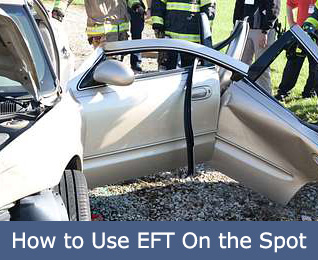Why Use EFT On the Spot for Trauma
In my experience, using EFT on the spot to handle emergencies can have enormous potential. If used right as the emergency is occurring, or directly afterwards, it could potentially forestall post traumatic stress disorder.
Typically, people share how they’ve used EFT (Emotional Freedom Technique) to clear a past trauma, handle ongoing personality issues, physical conditions, or in anticipation of an anxiety producing situation.
While the on-the-spot use of EFT is also reported, it is seemingly less often. Perhaps, when people do use it “on the spot,” like during a tedious dental appointment, it doesn’t seem noteworthy.
Nonetheless, I believe we can extract some recognizable principles for applying EFT under an array of emergency conditions, including during wartime or natural disasters. A simple, easily remembered protocol for such situations just might stave off many serious emotional problems.
To shed some light on this possibility, the following report was shared by Rehana Webster, a New Zealand EFT practitioner. In it, she describes her near fatal car accident and how her immediate use of EFT, right on the scene, averted a possibly strong post traumatic reaction.
EFT On the Spot: The Accident Details
Here is how Rehana used EFT on the spot to handle the aftermath of her accident.
One Spring day, I was in a horrific car accident and came within a nanosecond of being killed (decapitated). I was playing the tourist guide for my friend, Jon, who had just arrived from LA. We were driving around looking at some property in the country. At lunch time we stopped in the small town of Huntley on the Waikato River. It was a dismal day, gray, wet and blustery so we parked the car in front of a store and peered from the car to see if we could spot a restaurant close by.
Everything appeared normal. I looked in the mirrors to make sure it was safe before moving the car and waited for a large truck to pass us. A split second before it thundered past, there was a terrifying explosion. It was like a bomb going off. My car was flung forward with a tremendous jolt. Simultaneously the windows imploded, shattering inward and showering Jon and myself with glass. There was this strange silence like a moment frozen in time. The glass shards were everywhere. There were powdery bits that seemed to get into my eyes and nose and larger bits that stuck in my hair and skin.
It was like being in a slow motion movie as I watched the truck hurtle past my car with an eight foot metal attachment swinging wildly from the back it. Apparently, the flatbed truck, which was carrying a bobcat in a large cage, did not have the cage door secured. As it passed, the gate had swung open with its iron door swinging like a giant shovel and literally wiped out both the back and the driver’s side of my car–windows plus doors, and the car’s roof. I sat there feeling stunned, as if I had hit a brick wall with full impact, trying to take it all in until Jon came to his senses and got us out of the car.
It all seemed like a dream, actually a nightmare. My brain felt numb and foggy. We viewed the damage and realized how close I came to losing my head! The gate had narrowly missed hitting my head by 6 inches or less. It was at the same height as my head and had swung past it, knocking out the back and side windows plus the supports which hold up the roof of the car. I felt like I had been hit over the head with a sledge hammer, the result of the shock waves produced by the imploding windows. It seemed very much like an explosive device, bomb or dynamite going off in my close vicinity.
Anyway, the cops were called, and while we waited I took the opportunity to tap. I ran the whole event like a movie in my head, recalling the visual, auditory and kinesthetic experiences of the incident.
Her EFT On the Spot Tapping Focal Points
The things that really stood out in my mind as I tapped were:
- The gray wet weather (typical in New Zealand)
- The beat-up old truck, The BOOMING sound and earthshaking thud,
- The implosion of the car windows.
- The stinging of little pieces of glass in my neck, head, hair, face and the prickly feeling of the glass falling down my collar and back.
I also tapped on the ‘could have been’ aspects. The results were amazing. Not a twitch of fear as I recalled the accident. People were telling me that it was delayed shock. Well, I drove the next day…no jitters. More than a week later, and certainly no sign of delayed shock. In fact, I can barely recall any of the shock I felt then. It is as though the accident happened many years ago instead of last week. The memory of it seems faded and far away.
The Role of Submodalities
Particularly interesting is how Rehana systematically handled residual distress in ALL of her major senses — visual, auditory and kinesthetic, and then dealt with some cognitive factors, such as alarming self talk about the potential of it being a fatal accident, etc. She systematically forced herself to go through the different senses while under pressure and presumably not at her intellectual best, which was clearly effective.
Basically, she segmented the traumatic event into its sensory “submodalities,” a term initially associated with neuro-linguistic programming (NLP).
Ultimately, this approach could be useful for anyone dealing with a traumatic situation. However, having to think about how to handle an ongoing (or recent) crisis is hard to do if one is in a somewhat dazed state. It would surely be helpful not to have to try to figure out what to tap on, right? So let’s break it down.
Use Sensory Snapshots
To construct a crucial “EFT on the spot” framework for handling trauma in the immediate aftermath of a distressing event, spend a few moments taking “sensory snapshots” of what occurred. These can become the basis for creating your tapping phrases.
IMPORTANT NOTE: If the scenario was overly upsetting, consider using the “Tearless Trauma” technique. (See How to do EFT: A Step-by-Step Guide.)
Your sensory snapshots should include:
- VISUAL aspects of the scene that were particularly distressing
- SOUNDS that seem shocking to recall
- Physical SENSATIONS that were distressing
Your “sensory snapshots” can also include more detailed specifics like any sizes, colors, loudness, etc., that you recall. These are now the building blocks to revealing your full sensory experience of that event, which can help empower your EFT Tapping toward quelling its trauma.
In Closing
Often, many aspects of traumatic situations can become neglected if too general an approach is taken. The sooner all troubling aspects are addressed, the better.
With that, ponder this comment from Gary Craig: Excellent idea!! To take apart a memory and separate it into its sensory features allows us to get very specific. Even though it may take a little more time to do, it increases the odds of complete resolution of the problem.
About Rehana Webster, BSc – https://traumabustertechnique.com/about-rehana/






